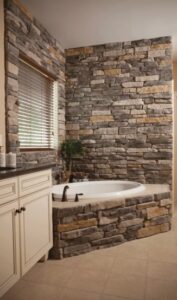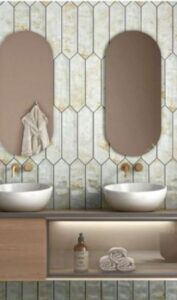Bathroom tiles play a crucial role in both the functionality and aesthetics of your bathroom.Vast array of colors, patterns, textures, and materials, they allow you to personalize your bathroom and create your desired ambiance. Overall, bathroom tiles offer a practical and stylish solution for creating a functional, beautiful, and safe bathroom environment.
Most popular bathroom tile type
Ceramic Tile: Ceramic tile is a type of tile that comes in a variety of colours, sizes, shapes, finishes, and textures. You can choose between rock and wood textures, which are ideal for a cosy themed bathroom.
Others may prefer pure wood texture tiles for their bathroom to achieve a natural theme.
Porcelain Tiles: Porcelain Tiles are made with a vitrification process. The process makes the tiles stronger and more resistant to water and thaw. Glazed surface provides the stain resistant surface finish to the tile.
Here are 10 DIY techniques to remove stains from bathroom tiles:
- Baking Soda Paste: Mix baking soda with water to create a paste. Apply it to the stained areas, scrub gently with a sponge or brush, and rinse thoroughly.
- Vinegar Solution: Combine equal parts white vinegar and water in a spray bottle. Spray the solution onto the stained tiles, let it sit for a few minutes, scrub with a brush, and rinse.
- Hydrogen Peroxide: Apply hydrogen peroxide directly to the stains, let it sit for a few minutes, scrub with a brush, and rinse. Test in an inconspicuous area first to ensure compatibility with your tiles.
- Lemon Juice: Squeeze fresh lemon juice onto the stains, let it sit for a few minutes, scrub with a sponge or brush, and rinse thoroughly.
- Oxygenated Bleach: Dissolve oxygenated bleach in water according to the package instructions. Apply the solution to the stains, scrub gently, and rinse well.
- Commercial Tile Cleaners: Use a commercial tile cleaner formulated to remove stains. Follow the manufacturer’s instructions carefully and ensure adequate ventilation.
- Steam Cleaning: Use a steam cleaner to loosen and remove stains from bathroom tiles. Steam cleaning is effective and chemical-free.
- Toothpaste: Apply a non-gel toothpaste directly to the stains, scrub with a toothbrush or sponge, and rinse thoroughly. Toothpaste with baking soda may be more effective.
- Rubbing Alcohol: Dampen a cloth or sponge with rubbing alcohol and wipe the stained areas. Rinse with water afterward.
- Magic Eraser: Use a melamine foam sponge (Magic Eraser) to gently scrub away stains from bathroom tiles. Wet the sponge, squeeze out excess water, and rub the stained areas in a circular motion.
Always test any cleaning solution or method in a small, inconspicuous area first to ensure it doesn’t damage or discolor your tiles. Additionally, wear gloves and ensure proper ventilation when using cleaning products.
FAQS
QUES 1 How to deep clean tile floors
ANS :- To deep clean tile floors, follow these steps:
- Sweep or Vacuum: Remove loose dirt, dust, and debris from the tile floor using a broom or vacuum cleaner with a soft brush attachment.
- Mop with Warm Water: Fill a bucket with warm water and add a mild detergent or tile cleaner according to the manufacturer’s instructions. Use a mop to clean the entire floor surface, working in small sections.
- Scrub Grout Lines: For stubborn stains or dirt in the grout lines, use a grout brush or an old toothbrush dipped in a mixture of water and baking soda or vinegar. Scrub gently to lift the dirt and rinse with clean water.
- Rinse Thoroughly: Once you’ve cleaned the entire floor, rinse it thoroughly with clean water to remove any soapy residue.
- Dry the Floor: Use a clean microfiber cloth or towel to dry the tile floor or allow it to air dry completely.
QUES 2 How do I make my tile floor shine?
ANS :- To make your tile floor shine, you can follow these additional steps:
- Use a Tile Cleaner with Shine Enhancers: Look for tile cleaners specifically formulated to add shine to the floor surface. Follow the manufacturer’s instructions for application.
- Apply a Tile Sealer: After deep cleaning, consider applying a tile sealer designed to enhance the shine and protect the surface. Be sure to choose a sealer appropriate for your type of tile.
- Buff with a Dry Cloth: Once the floor is dry, use a dry microfiber cloth or mop to buff the tile surface gently. This can help to bring out the natural shine of the tiles.
QUES 3 What is the best way to clean marble floors?
ANS :- For cleaning marble floors, follow these specialized steps:
- Dust Mop or Vacuum: Remove loose dirt and debris from the marble floor using a soft-bristled broom, dust mop, or vacuum cleaner with a brush attachment.
- Clean with a pH-Neutral Cleaner: Mix a pH-neutral stone cleaner with water according to the manufacturer’s instructions. Use a mop or soft cloth to clean the marble surface, avoiding harsh or acidic cleaners that can damage the stone.
- Spot Treat Stains: For stains or spills on marble floors, blot the area immediately with a clean cloth and a mild detergent solution. Avoid scrubbing, as this can scratch the marble.
- Rinse and Dry: Rinse the marble floor thoroughly with clean water to remove any remaining cleaner residue. Dry the surface with a soft cloth to prevent water spots or streaks.
- Polish if Desired: If you want to enhance the shine of your marble floor, you can polish it using a marble polishing powder or cream. Follow the manufacturer’s instructions carefully and buff the surface with a clean, dry cloth.
- Seal the Marble: Consider applying a marble sealant to protect the surface from stains and moisture. Choose a sealant specifically formulated for marble and follow the manufacturer’s instructions for application.










